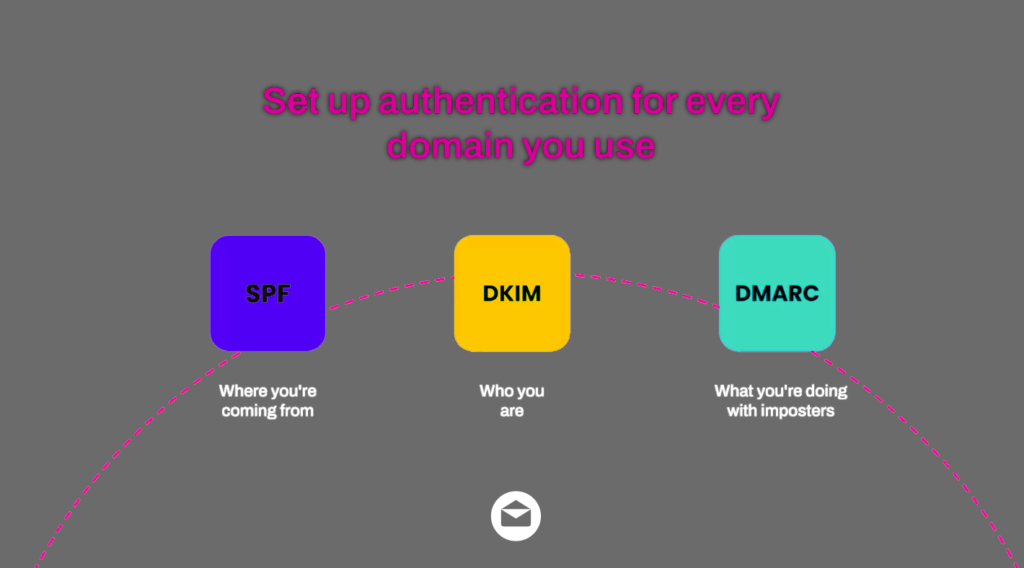Google and Yahoo’s Updates on SPF, DKIM, DMARC, and How it Affects Email Authentication & Deliverability
In the ever-evolving landscape of email, ensuring the security and authenticity of messages is paramount. Google & Yahoo, key players in the realm of email services, have implemented changes to enhance email authentication protocols. We’ll try and distill this down to more plain language and what it means for you.
We start with some technical aspects that need to be understood to have an actionable conversation. If you want you can skip down to that chunk, I’ll note it for ya.

SPF (Sender Policy Framework):
SPF is a widely used email authentication protocol designed to prevent email spoofing. It’s also been around for many many years, so it’s not exactly new per se. Google has introduced refinements to SPF to bolster its effectiveness in verifying the authenticity of email senders. This update aims to enhance the accuracy of SPF checks, reducing the likelihood of false positives or negatives.
In brief, Google wants to ensure that when an email comes in from you, it’s from you and not someone spoofing your email account to look like you.
DKIM (Domain Keys Identified Mail):
DKIM plays a crucial role in email security by adding a digital signature to each outgoing message, allowing recipients to verify its legitimacy. Google’s recent changes to DKIM involve strengthening the cryptographic mechanisms used in generating these signatures. This improvement contributes to a more robust authentication process, making it harder for malicious actors to forge email signatures.
DMARC (Domain-based Message Authentication, Reporting, & Conformance) Advancements:
DMARC acts as a comprehensive framework that builds upon SPF and DKIM to provide a layered defense against email spoofing and phishing. Google has introduced updates to DMARC to enhance its reporting capabilities, allowing domain owners to gain deeper insights into email authentication failures.
This empowers organizations to proactively address potential issues and further secure their email channels.
What These Changes Mean for You:
Improved Email Security: With the refined SPF, DKIM, and DMARC protocols, Google and Yahoo aim to create a more secure email ecosystem. Likely, other major email services (we’re looking at you Microsoft Outlook) will adopt these changes within their system sooner than later as well. This translates to better protection against phishing attempts and unauthorized email access. In brief, a safer internet.
Reduced False Positives: The updates to SPF and DKIM aim to reduce false positives in email authentication checks. This ensures that legitimate emails are not erroneously flagged as spam or phishing attempts. This piece is critical because it ensures that YOUR emails will make it from point A to point B, but only if the team configures all of these protocols properly.
Enhanced Reporting and Visibility: The advancements in DMARC reporting provide domain owners with valuable insights into authentication failures. This visibility allows organizations to take proactive measures to address potential issues promptly.
Invariably, things go wrong. But where is the problem and what can be done about it? This is where DMARC comes in and gives an IT team a trail to repair issues and ensure that the relevant domain is in good standing across the internet.
👉 Skip to Here:
Action Steps for Domain Owners:
Review and Update Authentication Settings: Ensure that your organization’s SPF, DKIM, and DMARC settings are up-to-date and aligned with the latest specifications. This is unique, per service, meaning if you’re set up on Google it’ll be a little different than say Outlook, which will both be a little different than Yahoo. Given this, the domain updates will be similar with some minor discrepancies, per the email platform.
Monitor Authentication Reports: Leverage the enhanced reporting capabilities of DMARC to monitor authentication failures and take corrective actions as needed. If you have an IT team, someone on that end will need to take the lead and become the monitor for deliverability for the domain. If there isn’t an IT team, it’s best to configure the settings and monitor deliverability rates over time to ensure things are making it into inboxes.
Once there’s a drop in email deliverability, then it’s time to escalate. When that happens, it likely won’t be subtle.
Educate Email Users: Educate your email users about these changes and encourage best practices for email security, such as avoiding clicking on suspicious links and reporting phishing attempts. It’s also a good idea to whitelist automated emails or general report-based emails within your account to ensure that they’re not being bounced, but rather are helpful. Something like a transactional receipt email or a daily brief that is exported from an often leveraged system or technology.
Tools that can Help:
Domain Checker: The good news in this is that there are FREE online tools that can help see where your domain stands and determine the next step(s). We leverage this free domain checker from dmarcian, which can help both initially and during the process of setting all of the various settings up for a domain.
Also, if deliverability is an issue your company can not afford to lose, then we offer a service to monitor your domain once these protocols are in place so you can largely make the change and rest easy.
The Big Picture:
Google’s updates to SPF, DKIM, and DMARC signify a commitment to strengthening email authentication standards. By staying informed and implementing best practices, organizations can bolster their email security posture and contribute to a safer online communication environment.
To be clear, all of these protocols have been around for years but what has changed is that Google moved from a position of “these protocols are a best practice” to “these protocols are a requirement.” This change means that we either keep up or lose deliverability to one of the largest email servers.
Stay vigilant, adapt to these changes, and secure your email channels in an ever-evolving digital landscape. If all of this was way too complicated, it may be a good idea to reach out and see if Pink Jacket can help, as it’s quickly becoming the new normal, but doesn’t have to be a thorn in your side.
We’re here to help. Talk soon!

